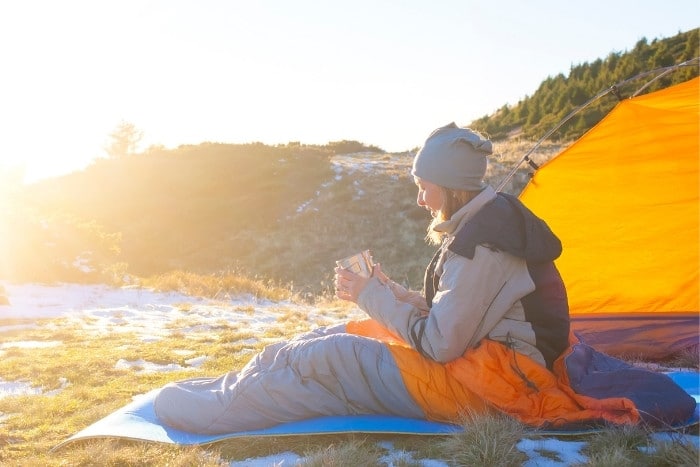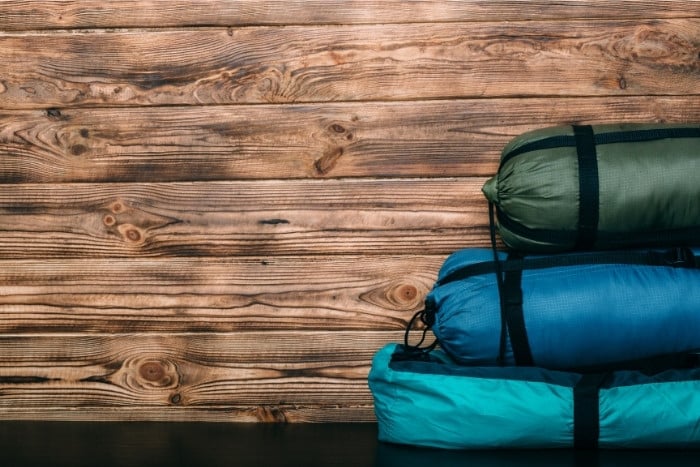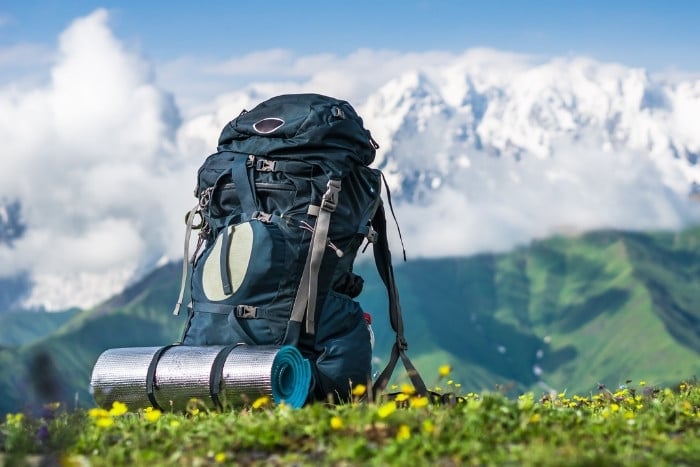You want to go camping but aren’t sure what equipment you need. Other campers rave about sleeping bags and sleeping pads, but do you need both? What is the difference between these two items, and when do you need each?
A sleeping bag is an insulated blanket that zips around you to preserve body heat while sleeping, and a sleeping pad is a pad you place under or inside your sleeping bag to cushion hard or uneven ground. It can provide insulation for winter camping trips. Use them together for the best results.
If you’re trying to decide what items are essential for your next camping trip, here is what you need to know about each item and how to shop for the perfect addition to your pack.
Do You Need a Sleeping Bag or a Sleeping Pad?
When heading out for your next camping expedition, you must come prepared to get cozy in your tent at night.
Most people know they need a sleeping bag to keep them in the best shape possible, but they aren’t sure whether they need a sleeping pad.
What’s the difference between these staple items in your camping pack? Sleeping bags are like a blanket that you wrap around yourself and zip closed when you sleep.
By zipping it shut, you’re effectively trapping your body heat inside the insulated lining, which can keep you warm through a chilly night.
Some bags are even equipped with a drawstring to tie tight around your head in the cold weather.
Sleeping pads are exactly what they sound like – pads that you place underneath your sleeping bag to protect you from the ground. Some are made of closed cell foam, while others are inflatable and air-filled.
They’re designed for comfort and insulating purposes, making them essential for winter camping.
The sleeping bag and sleeping pad combo are essential for your camping trip, especially if you plan to camp in cold weather. How do they work together to keep you comfortable?
1. Use Them Together for Best Results
The first thing you need to know about the sleeping pad and sleeping bag combination is that they’re designed to be used together.
When setting up your campsite, roll out a sleeping pad first to protect you from the ground. However, it’s about more than just comfort. Your sleeping pad also helps to insulate you.
This may not be necessary during spring or summer camping (depending on your region). When fall and winter roll around and the ground is colder, you’ll want this extra layer of insulation.
If you were to sleep directly on the ground, your body heat would transfer from inside your sleeping bag directly to the cold ground through a process known as conduction.
Your sleeping bag won’t be as thick once you’re inside it. This means that you’ll be closer than ever to the cold ground.
A sleeping pad keeps you off the ground and prevents your body heat from transferring from the warmth of your sleeping bag to the cold ground by interrupting the conduction process.
More than that, your sleeping pad gives you a bit more comfort than you may otherwise get. If you aren’t sure where you’ll be camping, packing a sleeping pad is essential.
That way, if you come across the perfect campsite, but it has uneven ground, a sleeping pad can minimize your overall discomfort.

2. Measuring Sleeping Bags vs Sleeping Pads
There’s a difference in the ratings between sleeping bags and pads. This can make shopping for them a bit challenging unless you’re prepared.
Sleeping bags are given a temperature rating, making choosing the right one straightforward. Some will have a higher temperature rating, making them ideal for warm-weather camping.
Be sure to consider where you do most of your camping and during which season. If you know you’ll be going winter camping; you might need a lower temperature rating.
On the other hand, you can buy a vapor barrier for a spring or summer sleeping bag that’ll give you an extra ten to fifteen degrees.
This might be all you need, depending on what part of the world you’ll camp in. Ratings on sleeping pads are a bit different. They are rated according to R-value, which measures how well they can resist heat flow.
A lower R-value means it won’t resist heat flow as much, so you’ll want an R-value of one or two for warm weather camping.
Winter camping will require a higher R-value to keep you warm on those long, cold nights. Most people feel more comfortable with an R-value of 4 or higher.
The maximum R-value is usually around 5.5, which could be ideal if camping in extremely cold circumstances.
3. Do You Always Need Both?
The truth is that you might be able to get away with camping without a sleeping bag during the summer months.
Since the temperatures will remain fairly high, even during the middle of the night, some campers prefer to pack as lightly as possible and drop the sleeping bag.
If you can bear the thought of sleeping without blankets, you have other options for eliminating a sleeping bag. You could also bring a light travel liner, a thin quilt, or a plain old blanket.
You’ll want a sleeping bag anytime the temperatures drop below 50 degrees Fahrenheit at night, as you can easily catch a chill.
Even if you have a sleeping bag rated for warmer weather, you won’t want to neglect packing one if there’s a chance that you could catch a chill. After all, this is an easy way to avoid catching a cold.
Not to mention, you’ll be far more comfortable while sleeping if you don’t have to worry about being too cold. This results in a better night of rest.
If you aren’t an experienced camper, you might not want to think about going on your trip with no sleeping pad.
They’ll keep you much more comfortable on the rough ground, but they could be a bit hot to sleep on during summer weather. They do insulate you, especially if you’re using a higher R-value.
If you want to avoid packing a sleeping pad, you could pack a small air mattress in a pinch.
However, this is likely to take up more space in your pack than a closed-cell foam sleeping pad would and can weigh more if you also have to pack a pump to get the air mattress into shape.
4. Types of Sleeping Bags
There are different types of sleeping bags and pads that you might want to consider. Sleeping bags are rated according to temperature:
- Summer bags (rated for 30 degrees Fahrenheit or higher)
- Three-season bags (15 to 30 degrees Fahrenheit)
- Winter bags (below 15 degrees Fahrenheit)
Beyond the temperature rating, there are also different shapes that you may want to consider depending on your sleeping style, whether you plan to share with someone else, or if you’re preparing for winter weather.
A rectangular sleeping bag comes to mind for most people, giving you the most room to wiggle your arms and legs.
It’s similar to a standard blanket, except you can zip it up and trap some of your body heat.
Mummy sleeping bags are often seen with low-temperature ratings because they can also trap the heat from your head.
There isn’t much room to move around because it offers a rather tight fit. It’s designed for warmth and is often fairly lightweight despite its warmth.
If you plan to share your body heat with your tentmate, rectangular bags are also designed for two people.
Double bags give you room to move around but have two zippers so that each person can zip themselves in and out of the sleeping bag.

5. Types of Sleeping Pads
Much like there are different sleeping bags, there are also several types of sleeping pads. One of the most common is an air pad, similar to an air mattress.
They’re the lightest type of sleeping pad, so you’ll want to highly consider this type if you’re planning on backpacking or traveling a great distance from your car to your campsite.
Closed-cell foam pads are great for campers on a budget, and they’re extremely light if weight is a consideration for your pack.
One of the benefits of closed cell foam is that you won’t have to worry about popping a hole in it over time. You’ll never have to worry about the pad losing air or comfort as you sleep.
A self-inflating pad is similar, but it combines the best of both air and open-cell foam. To get it up to par, you’ll just have to open the valve, which will expand.
It can also decrease in thickness to allow you to bundle it up in your backpack. Unlike open-cell foam, self-inflating pads can develop holes and rips.
6. Sleeping Pad Ratings
Because sleeping pads are all rated according to the same system, you’ll have an easier time when it comes to comparing the various options.
While they may be made of different materials, they all have a universal R-rating. This allows you to ensure you’re getting what you need from your sleeping pad.
Before you purchase a sleeping pad, it’s always a good idea to see them in person where you can lay on them and test them out before bringing one home.
Think about how comfortable the pad is, how much noise it makes when you move around, and whether you can fit on it or move around a little bit, as you would naturally do in your sleep.
This ensures you’ll be as comfortable as possible with your purchase, and your tent mates won’t be kept up all night with your tossing and turning on a loud sleeping pad.
7. Where to Position Sleeping Bags and Sleeping Pads
Suppose you’re trying to figure out how to get as comfortable as possible at your campsite. Should you place the sleeping pad beneath your sleeping bag or inside it?
Most campers prefer to put their sleeping pad underneath their sleeping bag, but you may roll off the sometimes-narrow pad. If you roll off the pad, you’ll find that you’ll be cold and uncomfortable.
This is why some people prefer to tuck their sleeping pads inside their sleeping bags. Placing it inside the sleeping bag allows you to ensure that you’ll never roll off of it.
Unfortunately, there are some things that you may need to consider if you plan to sleep with your pad inside of your bag.
First, the sleeping bag will have to be big enough and need to be the right size to fit a pad inside.
This arrangement allows the sleeping pad to move alongside the sleeping bag so that you’ll always have coverage from your pad. It won’t bunch up at the bottom, and you won’t roll off it.
Of course, if you plan to sleep in a hammock, it’ll be much easier to use if it’s tucked inside your sleeping bag. Remember that you may not stay as insulated if the sleeping pad is inside your bag.
If you plan to do a lot of winter camping, you might want to get a larger sleeping pad that gives you some more room to roll around in your sleeping bag on top of it.
Don’t forget to factor in your tent size to ensure that a larger sleeping pad will fit in tight quarters. This will increase your comfort and warmth over a chilly winter night.
8. Packing Only the Essentials
If you need to make sure you’re packing as lightly as possible, you’ll want to consider which items you’ll include in your pack.
A sleeping bag can be rolled tightly and fit nicely in your pack, but it can also be left behind in the warm weather.
On the other hand, a sleeping pad is considered an essential item for most campers. You won’t be very comfortable without a sleeping pad.
Consider how much extra weight you can reasonably carry to determine what type of pad is best for you. Backpackers and those trying to travel as lightly as possible will want a closed-cell foam sleeping pad.
Some people may also want to pack a pillow to improve their comfort. While it may not do much to keep you insulated or warm, it can work wonders to keep you as comfortable as possible.

Final Thoughts
Sleeping bags and sleeping pads are both essential parts of your camping gear, especially if you’ll be camping in winter weather.
You might be able to get away from using a sleeping bag in warmer weather, but a sleeping pad will be essential to keep you comfortable on rough or uneven ground.
Think about some of these factors when purchasing a new sleeping bag or pad for your next camping expedition!
